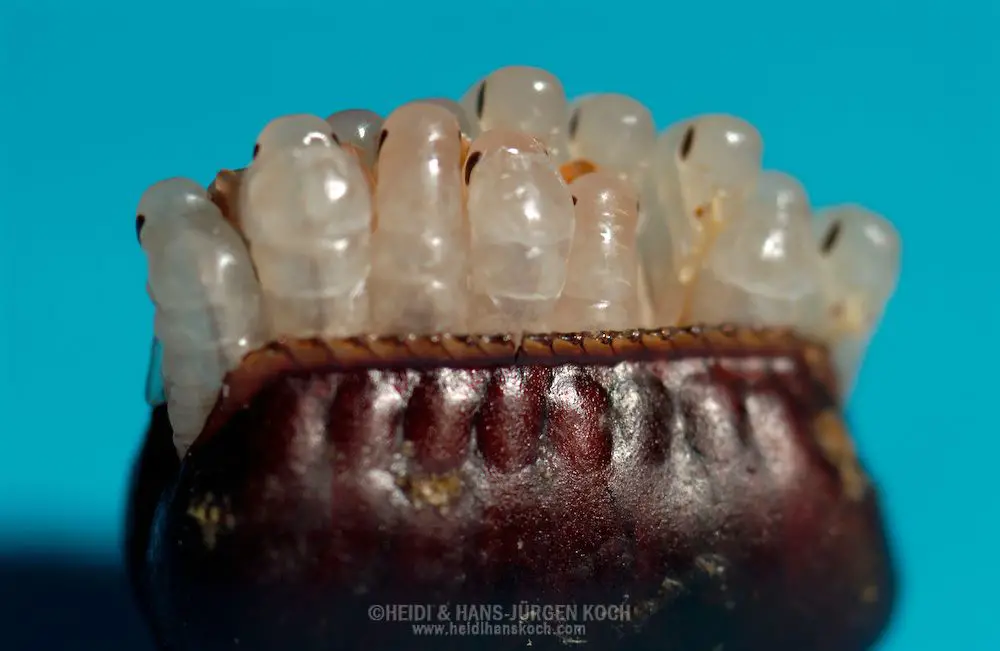The newborn babies of cockroaches are called nymphs. Before the nymph transforms into an adult roach, it must undergo between 8 to 10 series of changes.
Each successive stage is called a molt. During each subsequent molting stage, the roach has to shed an exoskeleton to accommodate the increasing size of the roach’s body.
An Albino roach or white cockroach is a cockroach without its brown-colored exoskeleton. The roach appears white or albino, mostly between successive stages of molting.
In contrast to mammals, the “Albino roach” is a misnomer because there aren’t any cockroaches with genetic abnormalities in their melanin production.

Do not worry; you are not alone if you have seen a White cockroach or an Albino roach.
These cockroaches are commonly seen around midsummers when it’s mostly warm and humid; this is the peak time for roach mating and reproduction.
I have been personally following white cockroaches and have discovered exciting facts that I will be sharing in the blog below.
Tired of cockroaches? Invest in only these products and follow the guide to eliminate roaches!
Use these products, and you will be roach free in less than a week.
1. Advion Cockroach Gel Bait (Review)
2. Gentrol IGR Point Source (Review)
Other Products to try:
1. Combat Roach Traps (Easy than gel baits)
2. Hot Shot Foggers (To kill in masses – 95%)
3. Pet Safe Killers (Uses Essential Oils)
4. Ortho Defence Outdoor Roach Killer (Prevent Roaches)
Is White Cockroach Rare?
Like every other organism living on the planet, roaches also reproduce. An American cockroach, aka palmetto bug, has the capability to produce approximately 120 to 180 baby bugs throughout life. Each baby palmetto bug or simply a baby cockroach is called a nymph. All the nymphs have to shed the brown-colored exoskeleton approximately eight times during transforming into adult bugs.
Once the cockroach has shed its exoskeleton, it will start to deposit a new one within the next few hours. After a day, the cockroach will again transform into a brown-colored roach. Therefore, we have a limited window period to see a white roach.
Is White Cockroach Rare? No! white cockroaches or albino roaches are not rare. As explained above, each nymph or baby bug has to shed an exoskeleton during transforming into an adult roach. Therefore it is 10X likely that you come across a white cockroach in your lifetime for the second time.
Another exciting question keeps poking our minds Are all Cockroaches White when they Molt? Yes! Almost every cockroach is white when they molt, but soon, within the next few hours, the color will change from yellow to brown, depending upon the species of roach.

Is White Cockroach Dangerous?
As described above, white roaches are nothing more than a typical roach without its exoskeleton. Keeping this in mind, the white roach is no more dangerous than other roaches.
The exoskeleton from white roach can trigger asthma attacks and nasal allergies. Apart from this, like other roaches, the white cockroach will transmit diseases like typhoid and paratyphoid.
How to Get Rid of White Roaches?
White roaches, due to their color, are excellent at hiding and are challenging to spot. Once you spot white roaches, killing them is no different than a typical brown roach.
You can kill a white roach using the Best insecticides & traps to kill a cockroach, a complete guide at selecting an appropriate roach killer. Natural Palmetto Bug Repellents are another excellent alternative for keeping them out of your space.
Does White Roaches mean Infestation?

Seeing a white roach means that you have probably come across roaches reproducing nearby in the vicinity. A cockroach is capable of producing approximately 180 baby bugs.
If you do not control the infestation, it is possible that soon your living space will turn into a roach harvesting ground. Therefore, seeing an albino roach signals infestation, usually in greater strength.
Boric acid stays on the surfaces for a long and will help you clear out the infestation. To know how to use boric acid, please read Does boric acid kill palmetto bugs and roaches?.